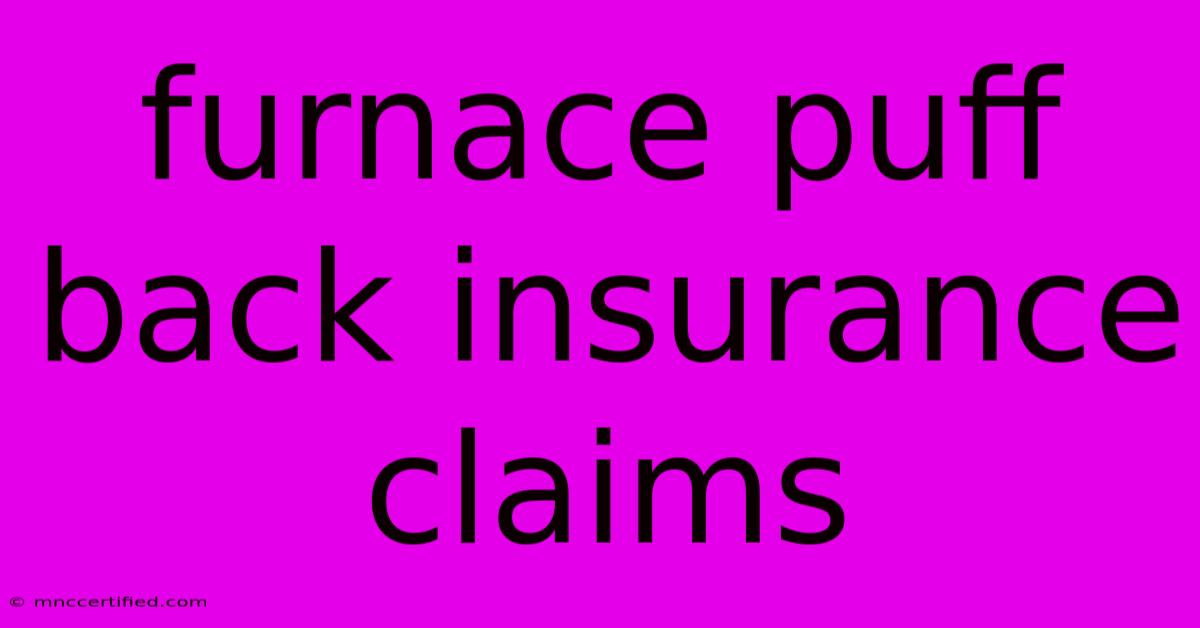Furnace Puff Back Insurance Claims

Table of Contents
Furnace Puff Back: Understanding Insurance Claims and Prevention
A furnace puff back is a terrifying event. The sudden, forceful expulsion of soot, flames, and potentially dangerous gases can cause significant damage to your home and pose a serious risk to your family's health. Understanding your insurance coverage and how to prevent this hazardous occurrence is crucial for every homeowner. This comprehensive guide will walk you through everything you need to know about furnace puff back insurance claims.
What is a Furnace Puff Back?
A furnace puff back happens when the combustion process in your furnace malfunctions, leading to a rapid buildup of pressure. This pressure eventually overcomes the system's safety mechanisms, resulting in a forceful backflow of combustion byproducts into your home. Several factors can trigger a puff back, including:
- Blocked or Restricted Vent: This is the most common cause. A clogged vent prevents proper exhaust of combustion gases, creating a pressure buildup. Things like debris, animal nests, or ice can all contribute to a blockage.
- Malfunctioning Draft Inducer: This component helps draw air into the furnace for combustion. A faulty inducer can disrupt the airflow, leading to a puff back.
- Dirty or Clogged Heat Exchanger: A buildup of debris on the heat exchanger can reduce its efficiency, impacting the combustion process and increasing the risk of a puff back.
- Improper Installation: Incorrectly installed furnaces are more prone to malfunctions, including puff backs.
- Insufficient Air Supply: A lack of sufficient outside air for combustion can also lead to pressure buildup.
Filing an Insurance Claim for Furnace Puff Back Damage
If you experience a furnace puff back, acting quickly is essential. Here's a step-by-step guide to filing a successful insurance claim:
1. Safety First:
- Evacuate your home immediately. The fumes from a puff back can be toxic.
- Contact your local fire department. They can assess the situation and ensure your safety.
- Do not attempt to restart your furnace.
2. Document the Damage:
- Take photos and videos of the damage to your home, including soot damage, structural damage, and any affected belongings.
- Create a detailed inventory of damaged items. Include purchase dates and estimated values.
- Keep records of all communication with your insurance company, including dates, times, and the names of individuals you spoke with.
3. Contact Your Insurance Company:
- Report the incident promptly. Most insurance policies have time limits for reporting claims.
- Provide all necessary documentation. This includes photos, videos, the inventory of damaged items, and any relevant repair estimates.
- Be prepared to answer questions about the circumstances surrounding the puff back. Your insurance adjuster may ask about furnace maintenance and recent inspections.
4. Work with Your Insurance Adjuster:
- Cooperate fully with the adjuster's investigation.
- Obtain multiple repair estimates for the damage to your home.
- Negotiate a fair settlement. If you disagree with the initial settlement offer, don't hesitate to appeal the decision.
What Your Insurance Policy Might Cover
Most homeowners' insurance policies cover damage caused by sudden and accidental events, like a furnace puff back. However, coverage can vary depending on your specific policy and the cause of the puff back. Some policies may exclude damage caused by neglect, improper maintenance, or pre-existing conditions. Review your policy carefully or consult with your insurance agent to understand your coverage limits.
Coverage typically includes:
- Repair or replacement of damaged property: This can include walls, ceilings, furniture, and personal belongings.
- Cleaning services: Professional cleaning is often necessary to remove soot and other contaminants.
- Temporary housing: If your home is uninhabitable, your insurance may cover the cost of temporary accommodation.
Preventing Future Puff Backs
Preventing a furnace puff back is far better than dealing with the aftermath. Here are some crucial preventative measures:
- Schedule annual furnace inspections and maintenance: A qualified technician can identify potential problems before they lead to a puff back.
- Regularly clean and inspect your furnace vent: Ensure the vent is free from obstructions.
- Replace your furnace filter regularly: A dirty filter restricts airflow and can contribute to malfunctions.
- Ensure adequate ventilation: Your furnace needs sufficient outside air for combustion.
Keywords: Furnace puff back, insurance claim, furnace maintenance, home insurance, soot damage, furnace repair, fire damage, home safety, insurance coverage, preventing furnace puff back, clogged vent, malfunctioning draft inducer, heat exchanger cleaning.
By understanding the risks and taking preventative measures, you can significantly reduce the chances of experiencing a furnace puff back. Remember, prompt action and thorough documentation are key to successfully filing an insurance claim if a puff back does occur.

Thank you for visiting our website wich cover about Furnace Puff Back Insurance Claims. We hope the information provided has been useful to you. Feel free to contact us if you have any questions or need further assistance. See you next time and dont miss to bookmark.
Featured Posts
-
Womens Match Report Tottenham 0 3
Nov 17, 2024
-
West Indies Vs England 4th T20 Live Score
Nov 17, 2024
-
Jutta Leerdam Pauls Girlfriends Slit Dress
Nov 17, 2024
-
Freedom Insurance Customer Service
Nov 17, 2024
-
Geico Insurance Card Template 2023
Nov 17, 2024